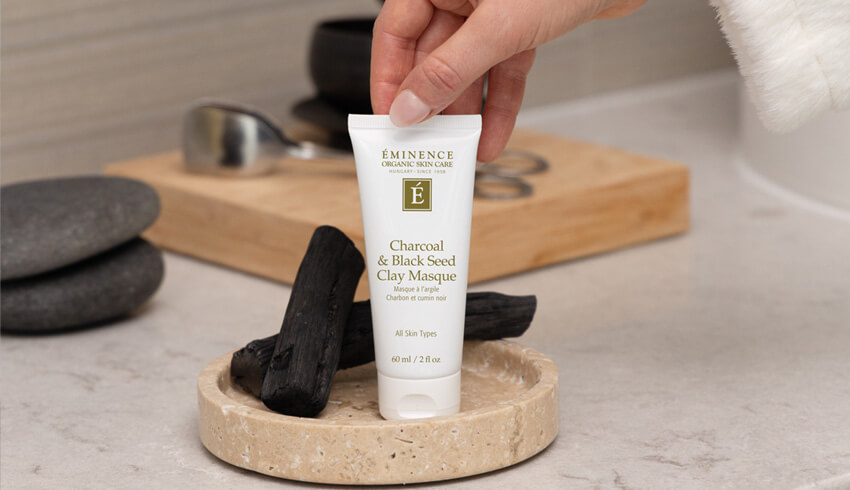
Acne depends on a combination of genetics, hormones and environmental influences, but what is less known is the link between diet and acne. Dermatologists have often recommended elimination diets to see what foods flare up your skin. But what about the reverse? Do acne-fighting foods exist? We explore both possibilities and find out what scientists say you should be eating vs what food to avoid for acne.
Food Groups To Enjoy
1. Omega-3 Fatty Acids
Omega-3 fats are healthy unsaturated fats that keep your immune system healthy and are found in:
- Fatty fish, such as salmon, mackerel, anchovies, trout
- Eggs
- Flaxseeds
- Walnuts
- Soybeans and tofu
Several studies have considered an association between increased severity of acne with lower consumption of fish, while another found that participants who consumed more fish and seafood experienced fewer acne symptoms, like blackheads, papules, pustules and oily skin. Omega-3 fatty acids have also been associated with a decrease in sebum production, a contributing factor to acne development.
2. Vegetables & Grains: A Low GI-Diet
The glycemic index (GI) is a measurement system that ranks foods according to their effect on your blood sugar levels. Many scientific studies support the idea that foods with a low glycemic index are associated with a reduction in breakouts and acne lesions. High GI foods are foods to avoid for acne, which include potatoes, white bread, pasta, pretzels, dates and chips.
According to the Mayo Clinic, low glycemic index foods you can enjoy include:
- Rice including basmati, doongara, long grain, brown
- Vegetables: sweet potatoes, carrots, broccoli, zucchini, cauliflower, celery and more
- Most fruits such as apples, strawberries and apricots
- Chickpeas, lentils, kidney beans
- Bran-based breakfast cereals like steel cut oats
Groups on low-glycemic load diets have seen a "significant" improvement of acne severity in comparison to those on a high glycemic diet after 12 weeks. Interestingly, one study even noted that the size of sebaceous glands was reduced in participants on a low glycemic load diet.

3. Complex Carbohydrates
Enjoying low glycemic foods made up of complex carbohydrates may also reduce your risk of developing acne. According to Healthline.com, complex carbohydrates include:
- Fruits and vegetables
- Nuts
- Wholegrains
Several studies suggest complex carbohydrates are a good food choice for reducing the occurrence of acne lesions, while also having other health benefits such as being a more stable source of energy. On the flip side, this means avoiding high glycemic and potentially acne-triggering simple carbohydrates, like pasta, white rice, white bread, sugar, soda and sweet biscuits to minimize the risk of breakouts.
4. Probiotics
Probiotics are live bacteria and yeasts that are good for your digestive system, especially for regulating gut health. Probiotics modulate the development of the immune system, often working to regulate the immune response toward anti-inflammatory states which could make them a good choice for those with inflammatory conditions like acne, skin inflammation, rosacea or dryness due to a damaged skin barrier.
According to Harvard Health, one of the best ways to consume more probiotics is to enjoy more fermented foods. Their list of the most common foods that naturally contain probiotics to help fight acne include:
- Yogurt
- Kefir
- Kombucha
- Sauerkraut
- Pickles
- Miso
- Tempeh
- Kimchi
- Sourdough bread
5. Tea
Tea drinkers rejoice! Due to the antioxidants and vitamins found in many popular herbal teas, tea drinking is a popular route to reducing the rate of acne. Matcha, turmeric, rooibos, spearmint and chamomile tea have all been recognized for their skin-clearing potential. In one study of 80 women aged 25 – 45 years, participants with acne consumed a decaffeinated green tea extract and almost 80% of study participants saw an improvement in their skin.
Green tea too has also been shown to reduce the number of inflammatory lesions on the nose and chin. In one study of 80 women aged 25 – 45 years, participants with acne consumed a decaffeinated green tea extract and almost 80% of study participants saw an improvement in their skin.
Foods You May Want To Avoid for Acne
While every person is different, scientific studies have advised some hesitation about consuming the following foods to reduce acne. We’d recommend always talking to your doctor or dermatologist before making major diet changes.
Alcohol
As Healthline states, drinking alcohol does not directly cause acne. However, it does influence your skin's health and may worsen acne. After all, alcohol is a diuretic, encouraging your body to get rid of fluids, potentially leading to dehydration and dry skin. Drying up the skin may cause the skin to look dull and fatigued, as well as bring out fine lines and wrinkles.
Alcohol may also aggravate skin due to the sugar and carbohydrate levels for some types of alcohol. Elevated glycemic indexes due to large amounts of carbohydates have been associated with acne,” dermatologist Dr. Blair Murphy-Rose tells Sunday Edit. Murphy-Rose believes that alcohol, particularly sugary mixed cocktails, can exacerbate breakouts due to sugar content
Milk Products
Many studies agree that consuming milk can irritate the skin or lead to an increase in acne lesions, but the jury is still out on why exactly this is. One theory suggests that since acne can be influenced by hormonal imbalances, adding additional hormones through animal milk may lead to breakouts.
One study goes as far as to say that “milk, milk protein supplements and other dairy products should be limited or completely eliminated” for those with acne. Skim milk has also been spotlighted for causing closed comedones due to suspected changes in the bioactivity of biologically active molecules in the production process.
However, it has also been suggested that fermented dairy products like kefir or buttermilk could benefit acne, due to the bacteria contained in these drinks (see our section on probiotics above). These beneficial bacteria could reduce skin inflammation and decrease sebum production.
Chocolate
Overall nutrition contributes to breakouts, where chocolate consumption is just a small part of the picture. As suggested earlier, high glycemic diets consisting of sugar, carbohydrates and fat — including sugary snacks, sugary drinks, processed cereals and breads — have been linked to inflammatory responses like acne. A low glycemic diet may help with acne breakouts as a result.
Several studies have reported a link between eating chocolate and developing breakouts, one noting a statistically significant increase in acne lesions after cocoa consumption and the other study seeing an increase in lesions just 48 hours after eating chocolate. However, much more research needs to be done.
Were you surprised at the foods that science says create the perfect conditions for acne? Tell us in the comments below or on social media on what foods you avoid or eat for acne.


